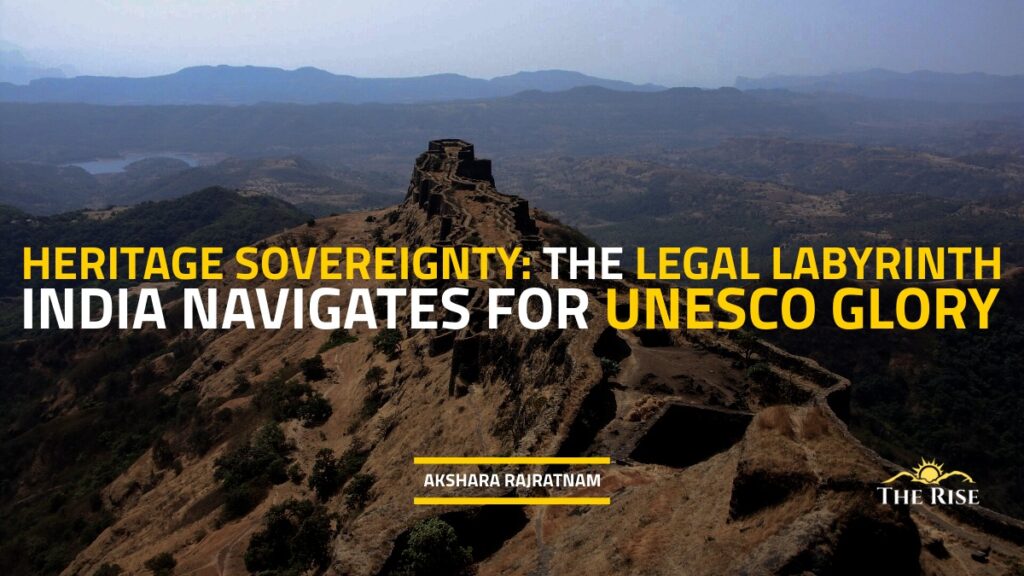As India contemplates future nominations from its provisional list, the implications are evident: UNESCO recognition confers international prestige and the potential to draw tourists, yet it also imposes intricate legal obligations that constrain policy autonomy for future generations.
When India celebrated the addition of the Maratha Military Landscapes to its list of UNESCO World Heritage sites in 2025, only a few knew they had just signed what legal experts describe as one of the most intricate and complex forms of international control ever created. The World Heritage Convention, signed by 196 countries in 1972, including India, provides rules that can supersede national policies. This contradiction between the local laws and international obligations is especially prominent in India, where rapid economic growth often gets in the way of efforts to protect cultural treasures.
The Sovereignty Surrender
The Maratha Military Landscapes, which include 12 forts in Maharashtra and Tamil Nadu, are an example of this intricate legal framework interfacing local and international laws. Local governments now have to deal with international legalities for what seems like regular maintenance. The state public works departments cannot just fix a broken rampart at Raigad Fort or damage from a storm at Gingee Fort. Before any intervention, UNESCO protocols, heritage management plans, and often the consent of international bureaucrats must be followed.
This creates a concept referred to as “cooperative sovereignty,” described by legal scholars as one wherein India maintains formal authority while acknowledging practical constraints through international collaboration. The implication of these restrictions became clear when monuments at Hampi were categorized as endangered from 1999 to 2006 because of the dangers posed by increased traffic and new buildings. This forced quick changes to policy and the adoption of costly measures to reduce the hazards.
The Taj Mahal Case: Two Decades of Legal Complexity
The Taj Mahal case exemplifies how heritage conservation can result in a convoluted network of legal intricacies. The Supreme Court of India has consistently intervened, instructing agencies like NEERI to evaluate the environmental impact of nearby industries on the monument, emphasizing the intersection of international heritage obligations with domestic judicial processes. Within the Taj Trapezium Zone, all transportation initiatives, urban planning decisions, and industrial licenses are now required to take into account international heritage consequences alongside national environmental and economic concerns.
Also Read: Why India’s Urban Transport Fails: Insights from TheRise Survey on Commuters, Traffic, and Safety
When development imperatives conflict with heritage protection, the legal framework becomes particularly complex. The exchequer has incurred thousands of crores in costs as a result of the construction of the Yamuna Expressway, numerous pollution control measures, and restrictions on industries in the vicinity of Agra, in addition to decades of litigation. Traditional property rights holders are now subject to restrictions that were never part of their original ownership terms, but have been imposed through international obligations their governments accepted decades ago.
The “In Danger” Mechanism: Lenient Intervention, Severe Consequences
UNESCO’s “In Danger” designation transitions heritage protection from cultural preservation to a form of contingent international engagement. Poaching and Bodo militant activity caused the Manas Wildlife Sanctuary to be listed as endangered from 1992 to 2011. This led to diplomatic scrutiny, conditional aid packages, and international monitoring missions, which India experienced firsthand. While the system introduces implicit conditionality, it does offer financial and technical help. However, countries incur reputational damages and potential declines in tourism if heritage assets remain “In Danger”, thus necessitating policy alterations that might affect the immediate national interests.
Constitutional Challenge: Federalism versus International Obligation
The federal structure of India introduces further complexity, as the cultural sites encompass numerous states with varying fiscal capacities and political priorities. The Maratha Military landscapes extend over Maharashtra and Tamil Nadu, necessitating coordination between the state governments due to their possibly divergent development plans. The Seventh Schedule of the Constitution of India categorizes “ancient and historical monuments” within the concurrent list, permitting both the central and state governments to enact legislation. The responsibilities of international heritage management predominantly rest with the Union government, which may lead to potential conflicts between the central and state authorities if state actions jeopardize UNESCO compliance.
The Legal Paradox: Older Sites, Stricter Controls
The latest Indian inscription honouring “17th–19th century” Maratha military architecture creates a compelling legal paradox: older sites are subject to stricter international restrictions. Due to their irreplaceability, prehistoric sites are protected by stringent regulations, although these protections generate ultra-modern constraints.
Also Read: Shifting Gears: How Women Cab Drivers Are Redefining Delhi’s Urban Mobility
International consultation is now necessary for even the most trivial interventions, such as pathway restorations or visitor facility enhancements, at archaeological sites such as the Ajanta and Ellora Caves, which were among India’s first World Heritage inscriptions in 1983. Decisions that once rested entirely on professional archaeological expertise now require the Archaeological Survey of India to balance visitor accessibility, conservation science, and adherence to UNESCO protocols.
The Future: Redefining Sovereignty in Heritage Conservation
The experience of India’s 44 Indian Heritage sites can help the country navigate the sovereignty-heritage issue. International obligations must be anticipated during nomination, stakeholder consensus must be built before inscription, and legal frameworks must be created to align with UNESCO criteria and local government systems for effective administration.
The notion of “cooperative sovereignty” must not be viewed as a reduction in autonomy, but rather as an augmentation of capacity—the capability to uphold vital national interests while acquiring international expertise, funding, and diplomatic influence. However, this requires a clear cost-benefit analysis and authentic stakeholder input before the acceptance of international commitments. As India contemplates future nominations from its provisional list, the implications are evident: UNESCO recognition confers international prestige and the potential to draw tourists, yet it also imposes intricate legal obligations that constrain policy autonomy for future generations. The objective is not to evade these constraints, but to acknowledge and manage them effectively.
Disclaimer: The views expressed in this article are those of the author solely. TheRise.co.in neither endorses nor is responsible for them. Reproducing this content without permission is prohibited.

